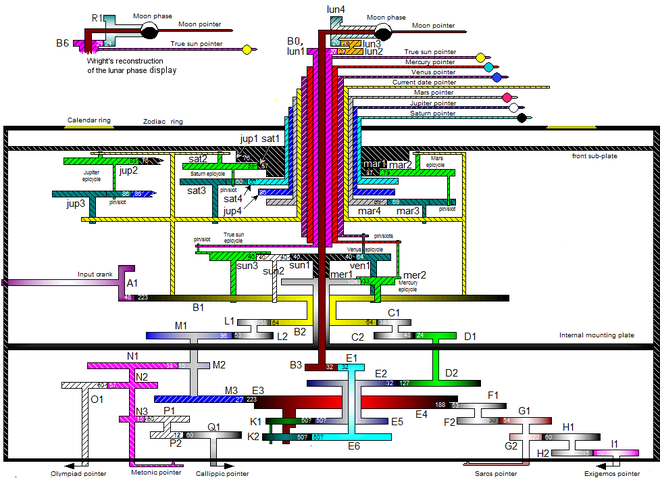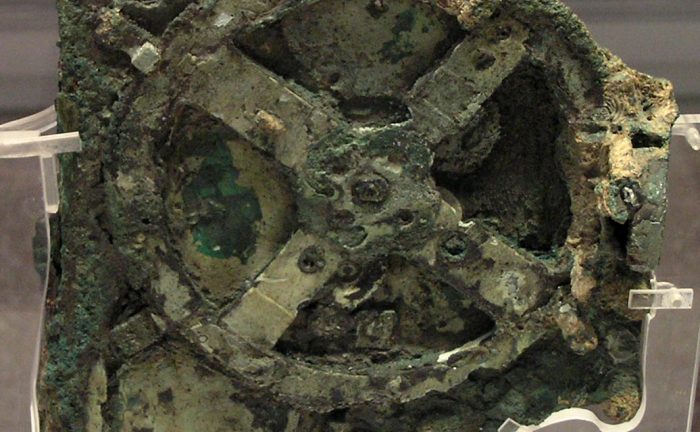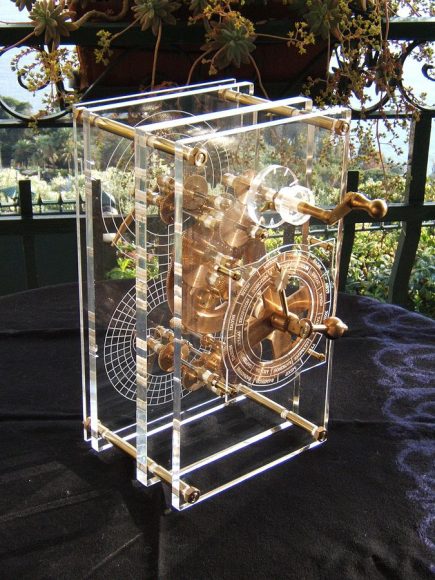

Johns Hopkins University (JHU) continues to pad its space community résumé with their interactive map, “The map of the observable Universe”, that takes viewers on a 13.7-billion-year-old tour of the cosmos from the present to the moments after the Big Bang. While JHU is responsible for creating the site, additional contributions were made by NASA, the European Space Agency, the National Science Foundation, and the Sloan Foundation.
Antikythera - Anticythère - ??t??????a - ????? Published on Jun 25, 2011 SUBSCRIBED 2.8K SUBSCRIBE SUBSCRIBED UNSUBSCRIBE More than 21 centuries ago, a mechanism of fabulous ingenuity was created in Greece, a device capable of indicating exactly how the sky would look for decades to come -- the position of the moon and sun, lunar phases and even eclipses. But this incredible invention would be drowned in the sea and its secret forgotten for two thousand years. This video is a tribute from Swiss clock-maker Hublot and film-maker Philippe Nicolet to this device, known as the Antikythera Mechanism, or the world's "first computer". The fragments of the Mechanism were discovered in 1901 by sponge divers near the island of Antikythera. It is kept since then at the National Archaeological Museum in Athens, Greece. For more than a century, researchers were trying to understand its functions. Since 2005, a pluridisciplinary research team, the "Antikythera Mechanism Research Project", is studying the Mechanism with the latest high tech available. The results of this ongoing research has enabled the construction of many models. Amongst them, the unique mechanism of a watch, designed by Hublot as a tribute to the Mechanism, is incorporating the known functions of this mysterious and fascinating ancient Mechanism. A model of the Antikythera Mechanism, built by the Aristotle University in Greece, together with the mechanism of the watch and this film in 3D are featuring in an exhibition about the Mechanism that is taking place in Paris, at the Musée des Arts et Métiers. The original fragments of the Mechanism, its main models and the watch designed by Hublot are on display at the National Archaeological Museum in Athens, Greece. Category Science & Technology License
<>
Jo Marchant is an award-winning science journalist and author of several popular science books including Decoding the Heavens: Solving the mystery of the world’s first computer and the New York Times bestseller Cure: A journey into the science of mind over body (both shortlisted for the Royal Society science books prize). She has a PhD in genetics, and has worked as a senior editor at New Scientist and at Nature. In 1901, sponge divers in the Mediterranean recovered several corroded pieces of bronze from an ancient shipwreck near the Greek island of Antikythera. Scholars soon noticed inscriptions on their surfaces, as well as traces of gearwheels, dials and pointers. These fragments were the remains of a mysterious and sophisticated device, dubbed the “Antikythera mechanism”. It turns out to be one of the most impressive items that survives from the ancient world and unique in the historical record, an unexpected treasure that has proved the ancient Greeks were capable of far more than we ever thought, and changed ideas about the origins of our own machines. In this lecture, I’ll tell the story of the mechanism’s discovery and the century-long race to decipher its workings; discuss what it means for the history of technology; and reveal the most recent insights into who built it and why.
Engineering Commons LLC:Home: Antikythera Mechanism Build Pictures: Planetarium Derivation: Equation of Time: Pin-Slot Anomaly Correction:
Around 60 BCE, a ship was sailing through the Straits between Crete and the Peloponnese. It passed the island of Egila, which had been known as a pirate hotspot just a few years earlier. Caught in a storm and unable to find shelter, the ship sank, taking the lives of at least four people. For copyright matters please contact us at:
Antikythera Mechanism Mystery Finally Solved By An AI, And It's Way Worse Than We Thought A rusted chunk of bronze, dragged up from the bottom of the Mediterranean, has flipped the story of ancient history on its head. This strange looking object is over two thousand years old, but inside it are gears so carefully made, they match the precision of today’s finest watches, long before anyone was supposed to know how to build such things. If something this advanced was lost for so long, what else is still buried out there? Could it mean we’re not the first advanced civilization to walk this planet? Join us as we find out all about the mysterious Antikythera Mechanism.
Further Reading: Clickspring Antikythera Build: • The Antikythera M... Antikythera Mechanism Research Project: Tony Freeth’s Presentation at Stanford: • The Antikythera M... Michael Wright at Computer History Museum: • Secrets of the An... Jo Marchant’s Talk at Darwin College: • Decoding the Heav... :Planetary Positions Chapters 0:00 Intro 0:30 Background 1:56 Gear Ratio Example 4:17 Reproductions 5:09 Changes 6:22 A Note on Friction 7:40 Changes 8:24 Spiral Pointers 10:21 Planetarium Design 13:45 Inferior Planets 15:58 Superior Planets 17:15 Lunar Anomaly 18:10 Equation of Time 21:31 Bevel Gears 22:40 Layout & Fabrication 24:20 Assembly 28:20 Usage 30:58 Outro
Learn the secrets of the enigmatic Antikythera Mechanism, a remarkable ancient device with intricate gears and astonishing astronomical functions that have astounded researchers for centuries. Dr. Tony Freeth is a founding member of the Antikythera Mechanism Research Project and an Honorary Senior Research Associate at University College, London. He holds degrees in Mathematics from Cambridge University (UK) and Bristol University (UK). His work on the Antikythera Mechanism has been published in Nature (Freeth et al, Nature 2006 and Freeth et al, Nature 2008) as well as other prominent journals. Youtube Membership Podcast: Apple: More JMG Want to support the channel? : Patreon Follow us at other places! @JMGEventHorizon Music featured on Event Horizon Stellardrone Bandcamp Miguel Johnson Leerosevere bandcamp Aeriumambient Bandcamp FOOTAGE: NASA ESA/Hubble ESO - M.Kornmesser ESO - L.Calcada ESO - Jose Francisco Salgado (josefrancisco.org) NAOJ University of Warwick Goddard Visualization Studio Langley Research Center Pixabay
isclaimer: Content on Qaunta is for entertainment only. While we aim for accuracy, our information may not be correct, up-to-date or complete. Always consult experts and do your own research. Enjoy, but question and explore further.

A schematic representation of the gearing of the Antikythera Mechanism, including the 2012 published interpretation of existing gearing, gearing added to complete known functions, and proposed gearing to accomplish additional functions, namely true sun pointer and pointers for the five then-known planets, as proposed by Freeth and Jones, 2012.[6] Based also upon similar drawing in the Freeth 2006 Supplement[42] and Wright 2005, Epicycles Part 2.[58] Proposed (as opposed to known from the artefact) gearing crosshatched. The Wkipedia Article on the Antikythera Mechanism
Published on Mar 20, 2014 The Antikythera Mechanism Research Project Latest news on the Antikythera Mechanism: Guardian science podcast from 9/2/15 Smithsonian Magazine article from February 2015: Jo Marchant's book on the subject Category Education License Standard YouTube License

The Antikythera Mechanism may be the world's oldest computer. Image: By Marsyas CC BY 2.5

A 2007 recreation of the Antikythera Mechanism. Image: I, Mogi, CC BY 2.5